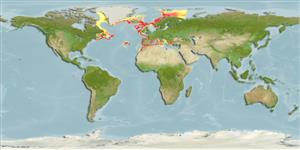Environment: milieu / climate zone / depth range / distribution range
Ecologia
marinhas demersal; não migratória; intervalo de profundidade 150 - 1000 m (Ref. 54594), usually 350 - 500 m (Ref. 54594). Temperate; 79°N - 29°N, 65°W - 44°E (Ref. 54594)
Northeast Atlantic: Southwestern Barents Sea, sometimes north to Spitsbergen, southeastern Greenland, southern coast of Iceland, around the British Isles and south to Morocco and into the western Mediterranean. Northwest Atlantic: Newfoundland.
Length at first maturity / Tamanho / Peso / Idade
Maturity: Lm 86.5 range ? - 88 cm
Max length : 155 cm TL macho/indeterminado; (Ref. 1371); peso máx. Publicado: 30.0 kg (Ref. 35388); Idade máx. registada: 20 anos (Ref. 1371)
Espinhos dorsais (total) : 0; Espinhos anais: 0; Raios anais moles: 70 - 81. Lower jaw longer than upper jaw; barbel shorter than eye diameter. Back gray-brown, grading to white ventrally. Posterior portions of vertical fins dark with pale margins.
Found mostly from 350-500 m depth on muddy bottoms. Feed on crustaceans and fish (flatfishes, gobies, rocklings) (Ref. 1371).
Cohen, D.M., T. Inada, T. Iwamoto and N. Scialabba, 1990. FAO species catalogue. Vol. 10. Gadiform fishes of the world (Order Gadiformes). An annotated and illustrated catalogue of cods, hakes, grenadiers and other gadiform fishes known to date. FAO Fish. Synop. 125(10). Rome: FAO. 442 p. (Ref. 1371)
Categoria na Lista Vermelha da IUCN (Ref. 130435: Version 2024-1)
Ameaça para o homem
Harmless
Utilização humana
Pescarias: espécies comerciais
Ferramentas
Relatórios especiais
Descarregue XML
Fontes da internet
Estimates based on models
Preferred temperature (Ref.
123201): 2.1 - 14.1, mean 6.3 °C (based on 199 cells).
Phylogenetic diversity index (Ref.
82804): PD
50 = 0.6250 [Uniqueness, from 0.5 = low to 2.0 = high].
Bayesian length-weight: a=0.00302 (0.00171 - 0.00533), b=3.03 (2.87 - 3.19), in cm total length, based on LWR estimates for this species & (Sub)family-body (Ref.
93245).
Nível Trófico (Ref.
69278): 4.5 ±0.6 se; based on diet studies.
Resiliência (Ref.
120179): Baixo, tempo mínimo de duplicação da população 4,5 - 14 anos (K=0.13-0.16; tm=8-11; tmax=20).
Prior r = 0.31, 95% CL = 0.20 - 0.46, Based on 3 full stock assessments.
Fishing Vulnerability (Ref.
59153): Very high vulnerability (75 of 100).
Climate Vulnerability (Ref.
125649): Moderate to high vulnerability (47 of 100).
Nutrients (Ref.
124155): Calcium = 16.4 [8.1, 35.6] mg/100g; Iron = 0.278 [0.142, 0.592] mg/100g; Protein = 17.6 [15.8, 19.3] %; Omega3 = 0.381 [0.204, 0.707] g/100g; Selenium = 29.8 [15.2, 59.6] μg/100g; VitaminA = 10.9 [2.7, 40.8] μg/100g; Zinc = 0.305 [0.198, 0.473] mg/100g (wet weight);
